Business Environment Analysis: Legal Structures and Economic Systems
VerifiedAdded on 2020/01/15
|20
|5470
|140
Report
AI Summary
This report provides a comprehensive analysis of the business environment, encompassing various aspects of organizational structure and economic systems. It begins by identifying different legal structures, such as charitable organizations, private limited companies, public limited companies, and partnerships, along with their respective purposes. The report then delves into stakeholder analysis, examining the expectations and objectives of stakeholders like governments, customers, and shareholders. It further explores the responsibilities of companies, emphasizing ethical considerations, corporate citizenship, and adherence to laws. The report also covers different economic systems, including free, command, and mixed economies, discussing resource allocation and control. It examines the impact of fiscal and monetary policies, as well as competition policies, on businesses. Furthermore, the report analyzes market structures, pricing, and output decisions, along with the influence of market forces on organizational responses. It assesses the business and cultural environment, highlighting the significance of international trade and global factors. Finally, it evaluates the impact of the European Union on UK businesses, providing a well-rounded overview of the business environment and its complexities.
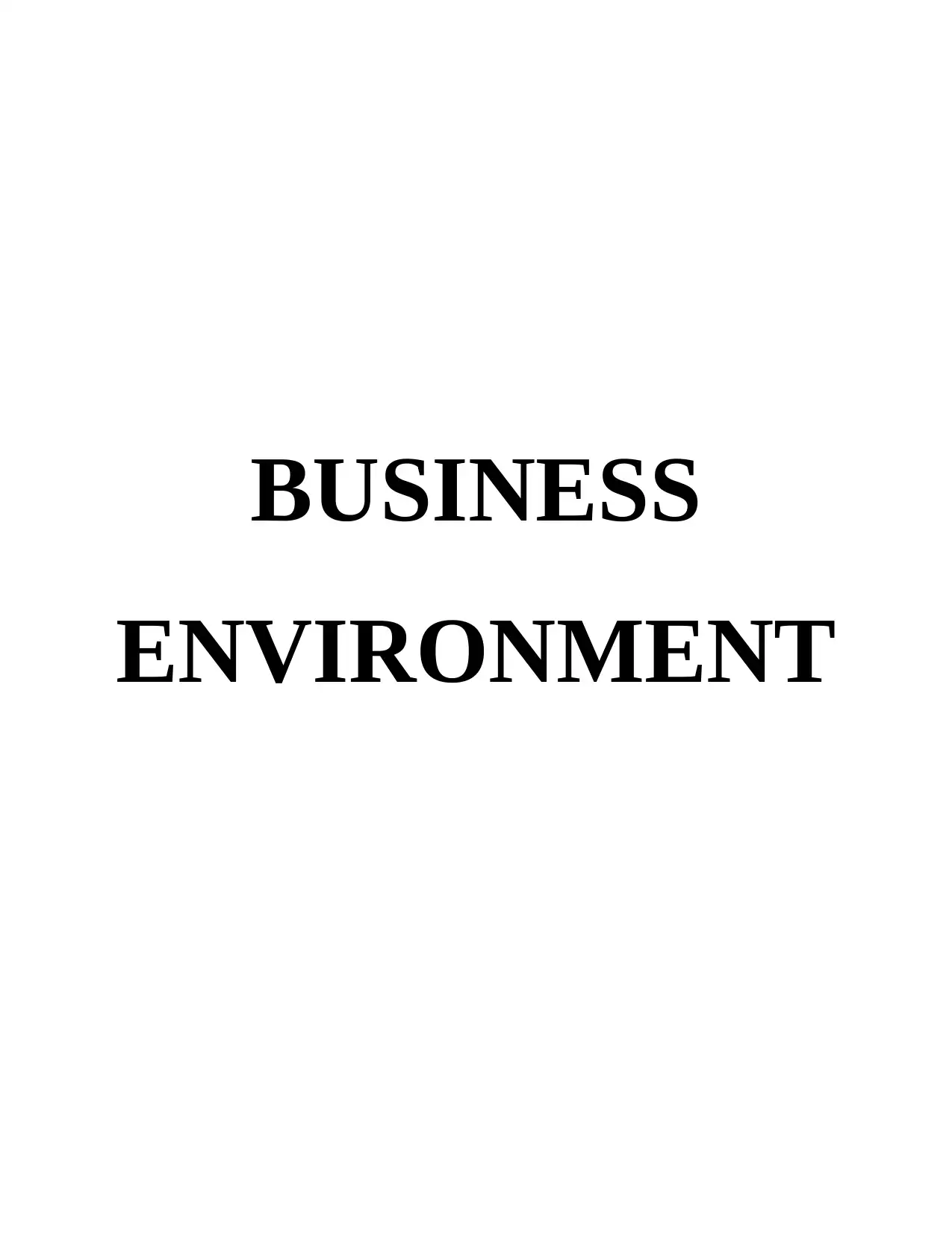
BUSINESS
ENVIRONMENT
ENVIRONMENT
Paraphrase This Document
Need a fresh take? Get an instant paraphrase of this document with our AI Paraphraser
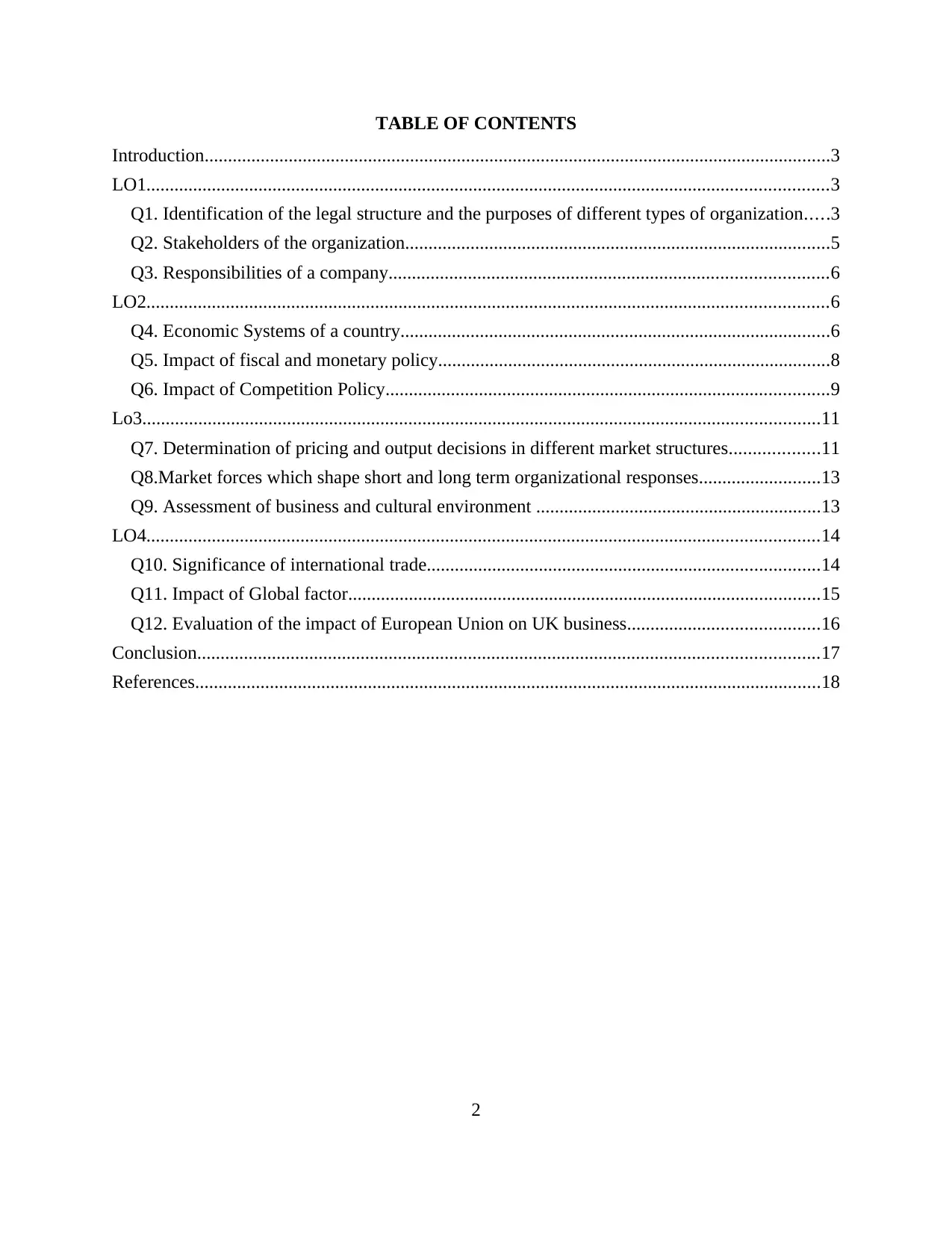
TABLE OF CONTENTS
Introduction......................................................................................................................................3
LO1..................................................................................................................................................3
Q1. Identification of the legal structure and the purposes of different types of organization.....3
Q2. Stakeholders of the organization...........................................................................................5
Q3. Responsibilities of a company..............................................................................................6
LO2..................................................................................................................................................6
Q4. Economic Systems of a country............................................................................................6
Q5. Impact of fiscal and monetary policy....................................................................................8
Q6. Impact of Competition Policy...............................................................................................9
Lo3.................................................................................................................................................11
Q7. Determination of pricing and output decisions in different market structures...................11
Q8.Market forces which shape short and long term organizational responses..........................13
Q9. Assessment of business and cultural environment .............................................................13
LO4................................................................................................................................................14
Q10. Significance of international trade....................................................................................14
Q11. Impact of Global factor.....................................................................................................15
Q12. Evaluation of the impact of European Union on UK business.........................................16
Conclusion.....................................................................................................................................17
References......................................................................................................................................18
2
Introduction......................................................................................................................................3
LO1..................................................................................................................................................3
Q1. Identification of the legal structure and the purposes of different types of organization.....3
Q2. Stakeholders of the organization...........................................................................................5
Q3. Responsibilities of a company..............................................................................................6
LO2..................................................................................................................................................6
Q4. Economic Systems of a country............................................................................................6
Q5. Impact of fiscal and monetary policy....................................................................................8
Q6. Impact of Competition Policy...............................................................................................9
Lo3.................................................................................................................................................11
Q7. Determination of pricing and output decisions in different market structures...................11
Q8.Market forces which shape short and long term organizational responses..........................13
Q9. Assessment of business and cultural environment .............................................................13
LO4................................................................................................................................................14
Q10. Significance of international trade....................................................................................14
Q11. Impact of Global factor.....................................................................................................15
Q12. Evaluation of the impact of European Union on UK business.........................................16
Conclusion.....................................................................................................................................17
References......................................................................................................................................18
2
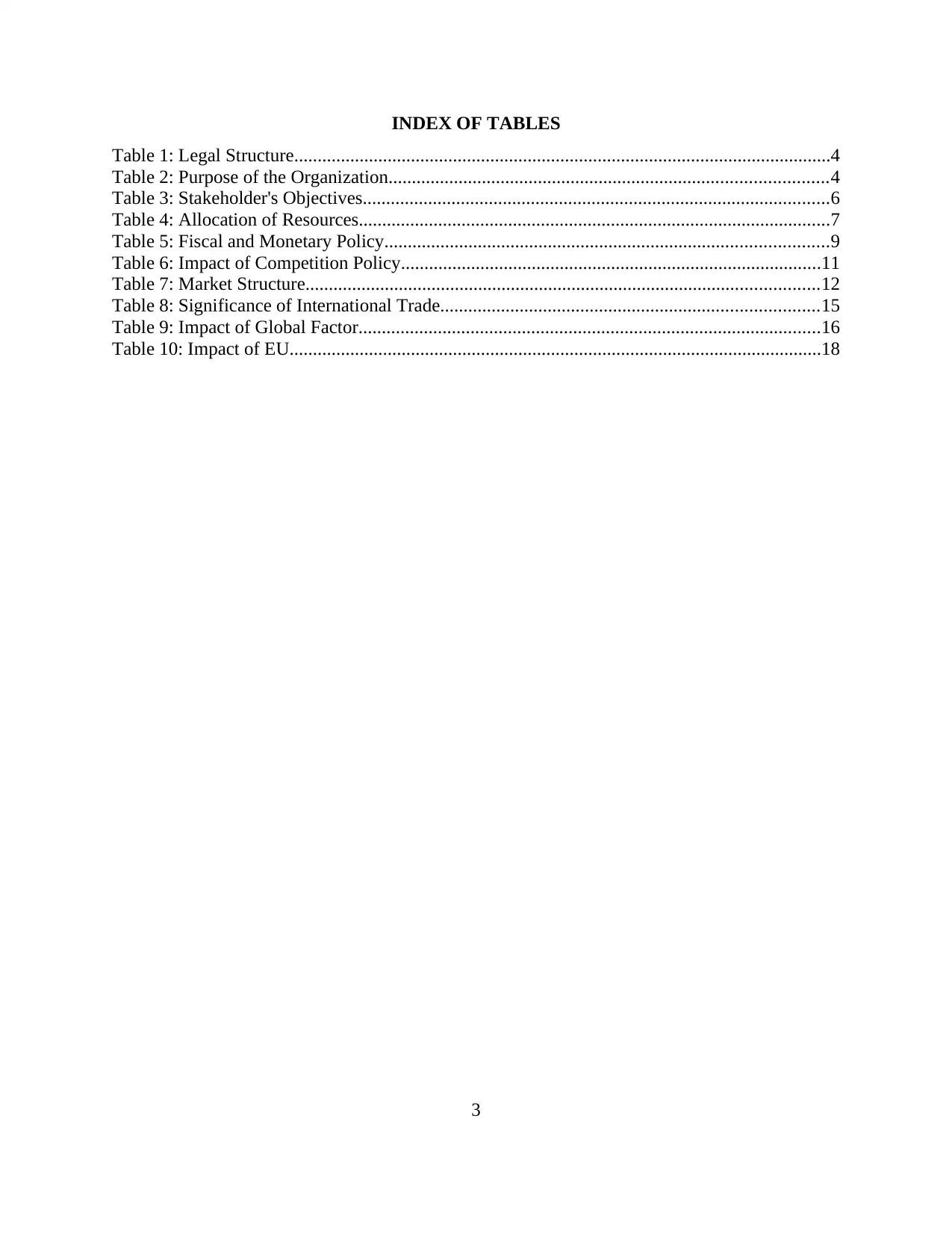
INDEX OF TABLES
Table 1: Legal Structure...................................................................................................................4
Table 2: Purpose of the Organization..............................................................................................4
Table 3: Stakeholder's Objectives....................................................................................................6
Table 4: Allocation of Resources.....................................................................................................7
Table 5: Fiscal and Monetary Policy...............................................................................................9
Table 6: Impact of Competition Policy..........................................................................................11
Table 7: Market Structure..............................................................................................................12
Table 8: Significance of International Trade.................................................................................15
Table 9: Impact of Global Factor...................................................................................................16
Table 10: Impact of EU..................................................................................................................18
3
Table 1: Legal Structure...................................................................................................................4
Table 2: Purpose of the Organization..............................................................................................4
Table 3: Stakeholder's Objectives....................................................................................................6
Table 4: Allocation of Resources.....................................................................................................7
Table 5: Fiscal and Monetary Policy...............................................................................................9
Table 6: Impact of Competition Policy..........................................................................................11
Table 7: Market Structure..............................................................................................................12
Table 8: Significance of International Trade.................................................................................15
Table 9: Impact of Global Factor...................................................................................................16
Table 10: Impact of EU..................................................................................................................18
3
⊘ This is a preview!⊘
Do you want full access?
Subscribe today to unlock all pages.

Trusted by 1+ million students worldwide
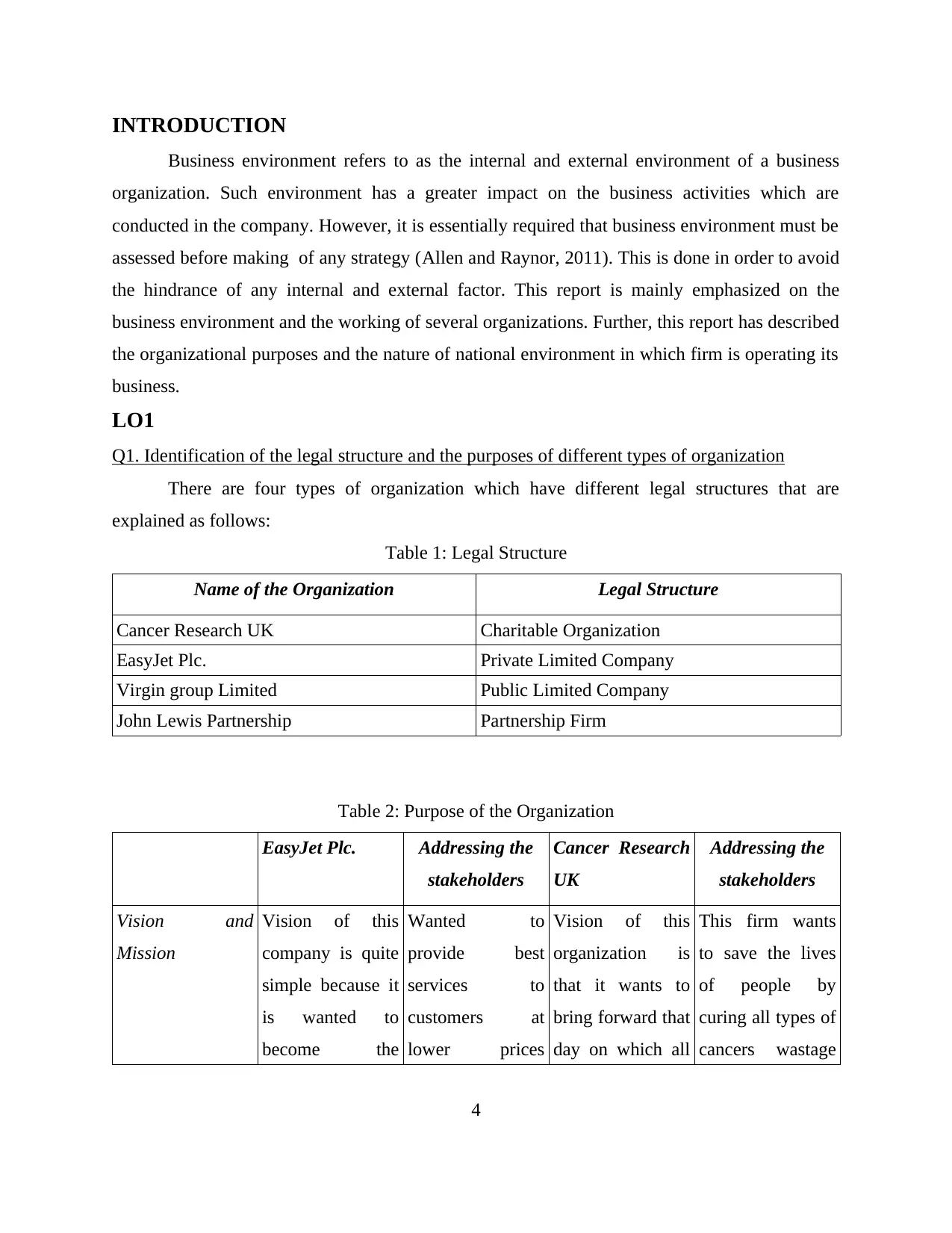
INTRODUCTION
Business environment refers to as the internal and external environment of a business
organization. Such environment has a greater impact on the business activities which are
conducted in the company. However, it is essentially required that business environment must be
assessed before making of any strategy (Allen and Raynor, 2011). This is done in order to avoid
the hindrance of any internal and external factor. This report is mainly emphasized on the
business environment and the working of several organizations. Further, this report has described
the organizational purposes and the nature of national environment in which firm is operating its
business.
LO1
Q1. Identification of the legal structure and the purposes of different types of organization
There are four types of organization which have different legal structures that are
explained as follows:
Table 1: Legal Structure
Name of the Organization Legal Structure
Cancer Research UK Charitable Organization
EasyJet Plc. Private Limited Company
Virgin group Limited Public Limited Company
John Lewis Partnership Partnership Firm
Table 2: Purpose of the Organization
EasyJet Plc. Addressing the
stakeholders
Cancer Research
UK
Addressing the
stakeholders
Vision and
Mission
Vision of this
company is quite
simple because it
is wanted to
become the
Wanted to
provide best
services to
customers at
lower prices
Vision of this
organization is
that it wants to
bring forward that
day on which all
This firm wants
to save the lives
of people by
curing all types of
cancers wastage
4
Business environment refers to as the internal and external environment of a business
organization. Such environment has a greater impact on the business activities which are
conducted in the company. However, it is essentially required that business environment must be
assessed before making of any strategy (Allen and Raynor, 2011). This is done in order to avoid
the hindrance of any internal and external factor. This report is mainly emphasized on the
business environment and the working of several organizations. Further, this report has described
the organizational purposes and the nature of national environment in which firm is operating its
business.
LO1
Q1. Identification of the legal structure and the purposes of different types of organization
There are four types of organization which have different legal structures that are
explained as follows:
Table 1: Legal Structure
Name of the Organization Legal Structure
Cancer Research UK Charitable Organization
EasyJet Plc. Private Limited Company
Virgin group Limited Public Limited Company
John Lewis Partnership Partnership Firm
Table 2: Purpose of the Organization
EasyJet Plc. Addressing the
stakeholders
Cancer Research
UK
Addressing the
stakeholders
Vision and
Mission
Vision of this
company is quite
simple because it
is wanted to
become the
Wanted to
provide best
services to
customers at
lower prices
Vision of this
organization is
that it wants to
bring forward that
day on which all
This firm wants
to save the lives
of people by
curing all types of
cancers wastage
4
Paraphrase This Document
Need a fresh take? Get an instant paraphrase of this document with our AI Paraphraser
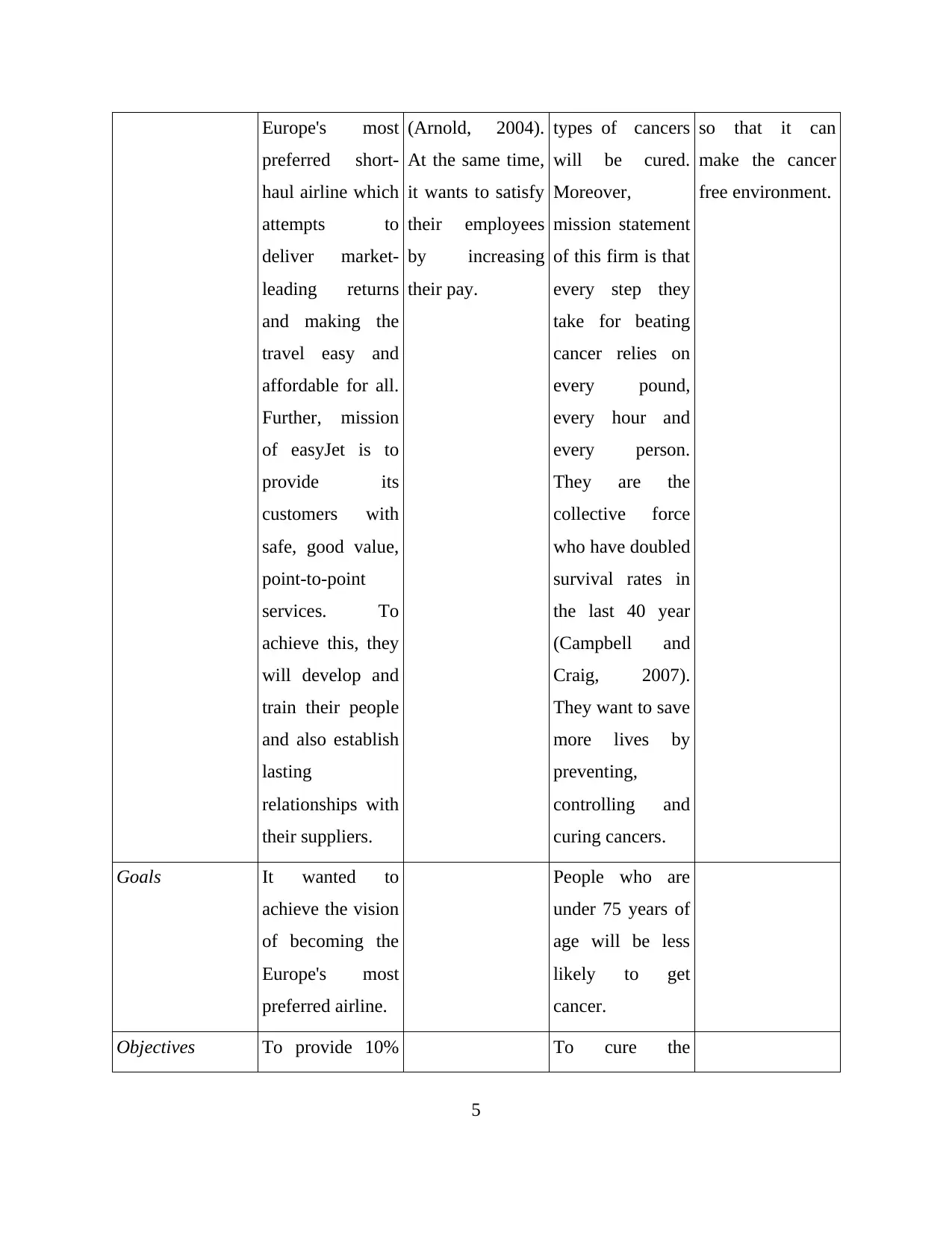
Europe's most
preferred short-
haul airline which
attempts to
deliver market-
leading returns
and making the
travel easy and
affordable for all.
Further, mission
of easyJet is to
provide its
customers with
safe, good value,
point-to-point
services. To
achieve this, they
will develop and
train their people
and also establish
lasting
relationships with
their suppliers.
(Arnold, 2004).
At the same time,
it wants to satisfy
their employees
by increasing
their pay.
types of cancers
will be cured.
Moreover,
mission statement
of this firm is that
every step they
take for beating
cancer relies on
every pound,
every hour and
every person.
They are the
collective force
who have doubled
survival rates in
the last 40 year
(Campbell and
Craig, 2007).
They want to save
more lives by
preventing,
controlling and
curing cancers.
so that it can
make the cancer
free environment.
Goals It wanted to
achieve the vision
of becoming the
Europe's most
preferred airline.
People who are
under 75 years of
age will be less
likely to get
cancer.
Objectives To provide 10% To cure the
5
preferred short-
haul airline which
attempts to
deliver market-
leading returns
and making the
travel easy and
affordable for all.
Further, mission
of easyJet is to
provide its
customers with
safe, good value,
point-to-point
services. To
achieve this, they
will develop and
train their people
and also establish
lasting
relationships with
their suppliers.
(Arnold, 2004).
At the same time,
it wants to satisfy
their employees
by increasing
their pay.
types of cancers
will be cured.
Moreover,
mission statement
of this firm is that
every step they
take for beating
cancer relies on
every pound,
every hour and
every person.
They are the
collective force
who have doubled
survival rates in
the last 40 year
(Campbell and
Craig, 2007).
They want to save
more lives by
preventing,
controlling and
curing cancers.
so that it can
make the cancer
free environment.
Goals It wanted to
achieve the vision
of becoming the
Europe's most
preferred airline.
People who are
under 75 years of
age will be less
likely to get
cancer.
Objectives To provide 10% To cure the
5
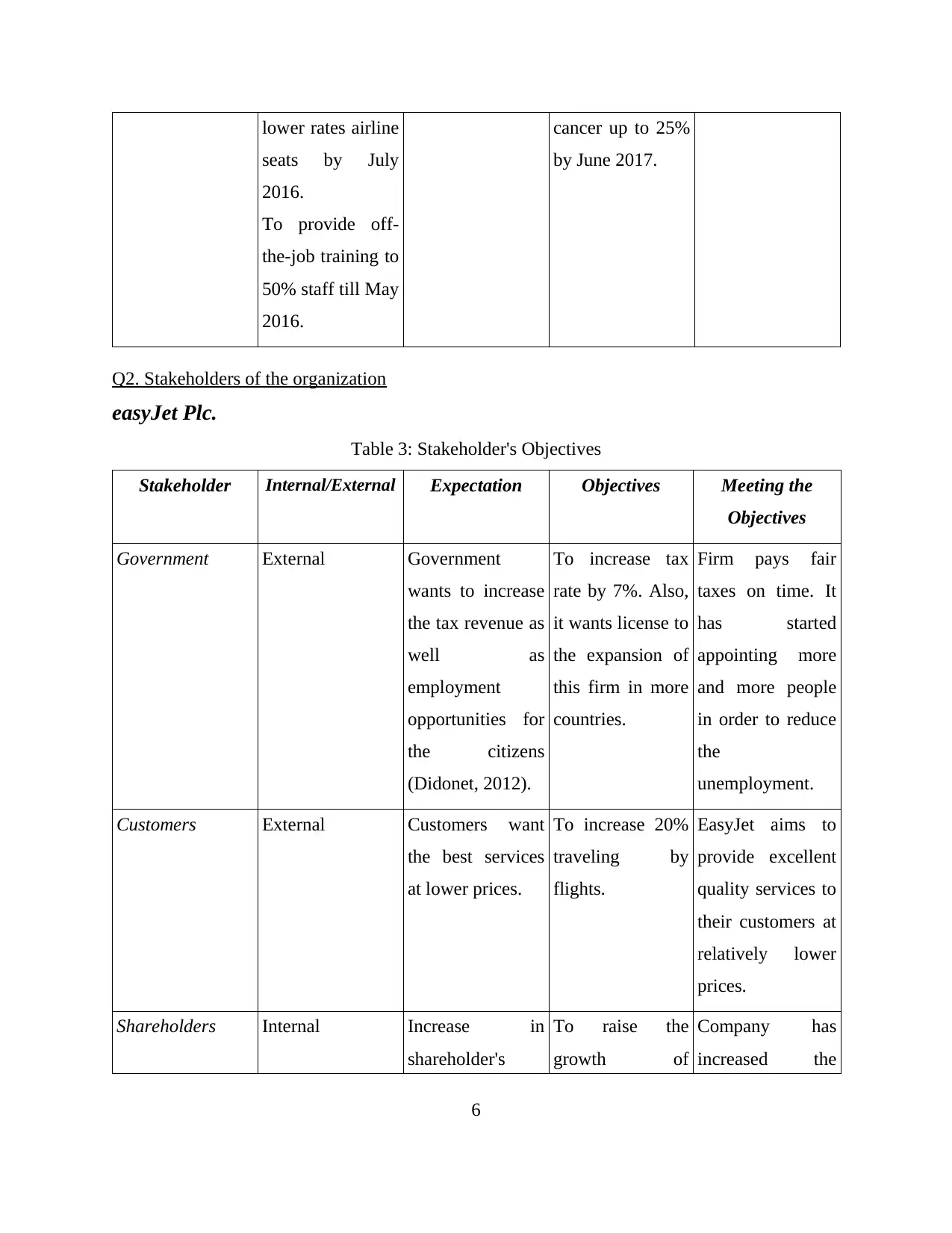
lower rates airline
seats by July
2016.
To provide off-
the-job training to
50% staff till May
2016.
cancer up to 25%
by June 2017.
Q2. Stakeholders of the organization
easyJet Plc.
Table 3: Stakeholder's Objectives
Stakeholder Internal/External Expectation Objectives Meeting the
Objectives
Government External Government
wants to increase
the tax revenue as
well as
employment
opportunities for
the citizens
(Didonet, 2012).
To increase tax
rate by 7%. Also,
it wants license to
the expansion of
this firm in more
countries.
Firm pays fair
taxes on time. It
has started
appointing more
and more people
in order to reduce
the
unemployment.
Customers External Customers want
the best services
at lower prices.
To increase 20%
traveling by
flights.
EasyJet aims to
provide excellent
quality services to
their customers at
relatively lower
prices.
Shareholders Internal Increase in
shareholder's
To raise the
growth of
Company has
increased the
6
seats by July
2016.
To provide off-
the-job training to
50% staff till May
2016.
cancer up to 25%
by June 2017.
Q2. Stakeholders of the organization
easyJet Plc.
Table 3: Stakeholder's Objectives
Stakeholder Internal/External Expectation Objectives Meeting the
Objectives
Government External Government
wants to increase
the tax revenue as
well as
employment
opportunities for
the citizens
(Didonet, 2012).
To increase tax
rate by 7%. Also,
it wants license to
the expansion of
this firm in more
countries.
Firm pays fair
taxes on time. It
has started
appointing more
and more people
in order to reduce
the
unemployment.
Customers External Customers want
the best services
at lower prices.
To increase 20%
traveling by
flights.
EasyJet aims to
provide excellent
quality services to
their customers at
relatively lower
prices.
Shareholders Internal Increase in
shareholder's
To raise the
growth of
Company has
increased the
6
⊘ This is a preview!⊘
Do you want full access?
Subscribe today to unlock all pages.

Trusted by 1+ million students worldwide
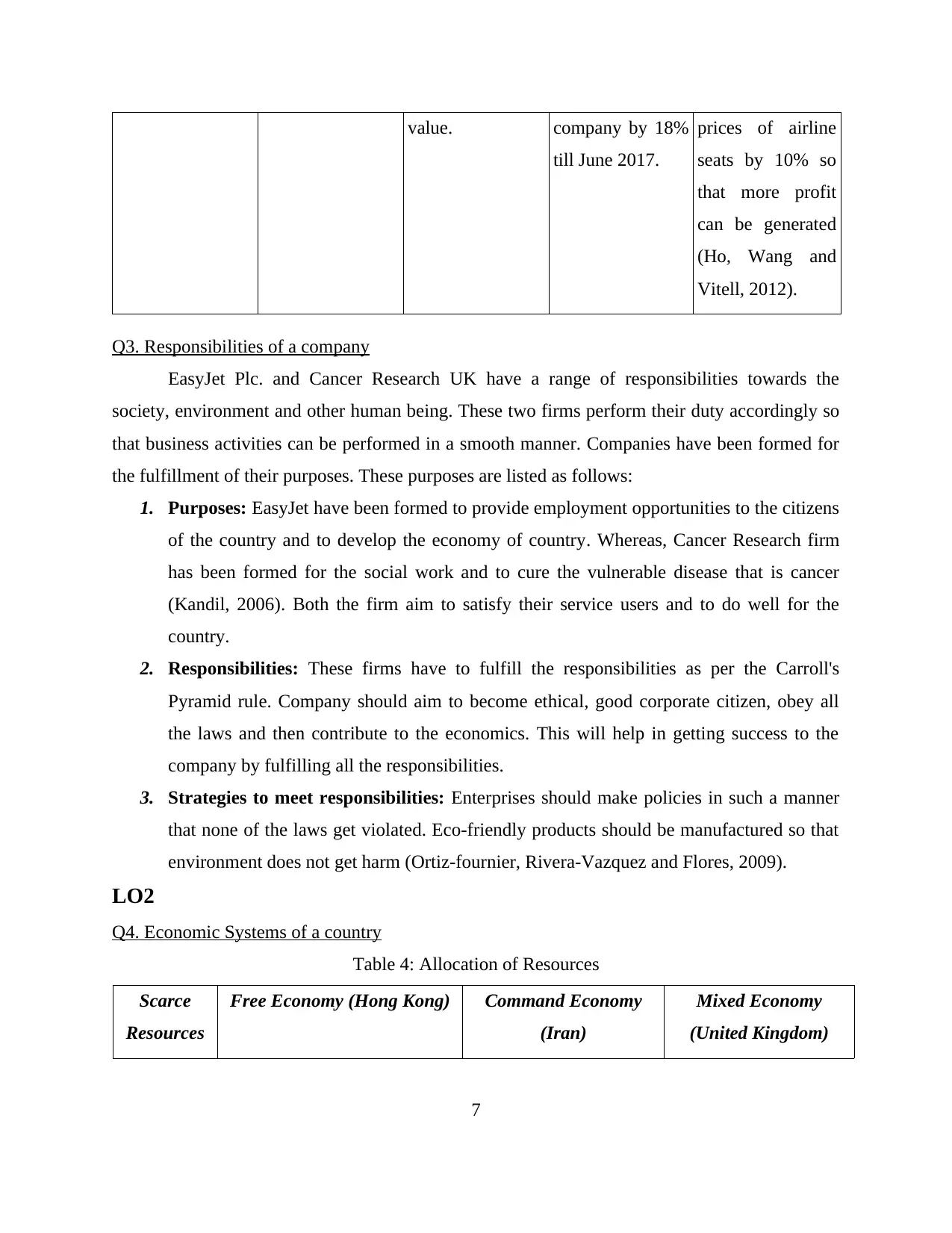
value. company by 18%
till June 2017.
prices of airline
seats by 10% so
that more profit
can be generated
(Ho, Wang and
Vitell, 2012).
Q3. Responsibilities of a company
EasyJet Plc. and Cancer Research UK have a range of responsibilities towards the
society, environment and other human being. These two firms perform their duty accordingly so
that business activities can be performed in a smooth manner. Companies have been formed for
the fulfillment of their purposes. These purposes are listed as follows:
1. Purposes: EasyJet have been formed to provide employment opportunities to the citizens
of the country and to develop the economy of country. Whereas, Cancer Research firm
has been formed for the social work and to cure the vulnerable disease that is cancer
(Kandil, 2006). Both the firm aim to satisfy their service users and to do well for the
country.
2. Responsibilities: These firms have to fulfill the responsibilities as per the Carroll's
Pyramid rule. Company should aim to become ethical, good corporate citizen, obey all
the laws and then contribute to the economics. This will help in getting success to the
company by fulfilling all the responsibilities.
3. Strategies to meet responsibilities: Enterprises should make policies in such a manner
that none of the laws get violated. Eco-friendly products should be manufactured so that
environment does not get harm (Ortiz-fournier, Rivera-Vazquez and Flores, 2009).
LO2
Q4. Economic Systems of a country
Table 4: Allocation of Resources
Scarce
Resources
Free Economy (Hong Kong) Command Economy
(Iran)
Mixed Economy
(United Kingdom)
7
till June 2017.
prices of airline
seats by 10% so
that more profit
can be generated
(Ho, Wang and
Vitell, 2012).
Q3. Responsibilities of a company
EasyJet Plc. and Cancer Research UK have a range of responsibilities towards the
society, environment and other human being. These two firms perform their duty accordingly so
that business activities can be performed in a smooth manner. Companies have been formed for
the fulfillment of their purposes. These purposes are listed as follows:
1. Purposes: EasyJet have been formed to provide employment opportunities to the citizens
of the country and to develop the economy of country. Whereas, Cancer Research firm
has been formed for the social work and to cure the vulnerable disease that is cancer
(Kandil, 2006). Both the firm aim to satisfy their service users and to do well for the
country.
2. Responsibilities: These firms have to fulfill the responsibilities as per the Carroll's
Pyramid rule. Company should aim to become ethical, good corporate citizen, obey all
the laws and then contribute to the economics. This will help in getting success to the
company by fulfilling all the responsibilities.
3. Strategies to meet responsibilities: Enterprises should make policies in such a manner
that none of the laws get violated. Eco-friendly products should be manufactured so that
environment does not get harm (Ortiz-fournier, Rivera-Vazquez and Flores, 2009).
LO2
Q4. Economic Systems of a country
Table 4: Allocation of Resources
Scarce
Resources
Free Economy (Hong Kong) Command Economy
(Iran)
Mixed Economy
(United Kingdom)
7
Paraphrase This Document
Need a fresh take? Get an instant paraphrase of this document with our AI Paraphraser
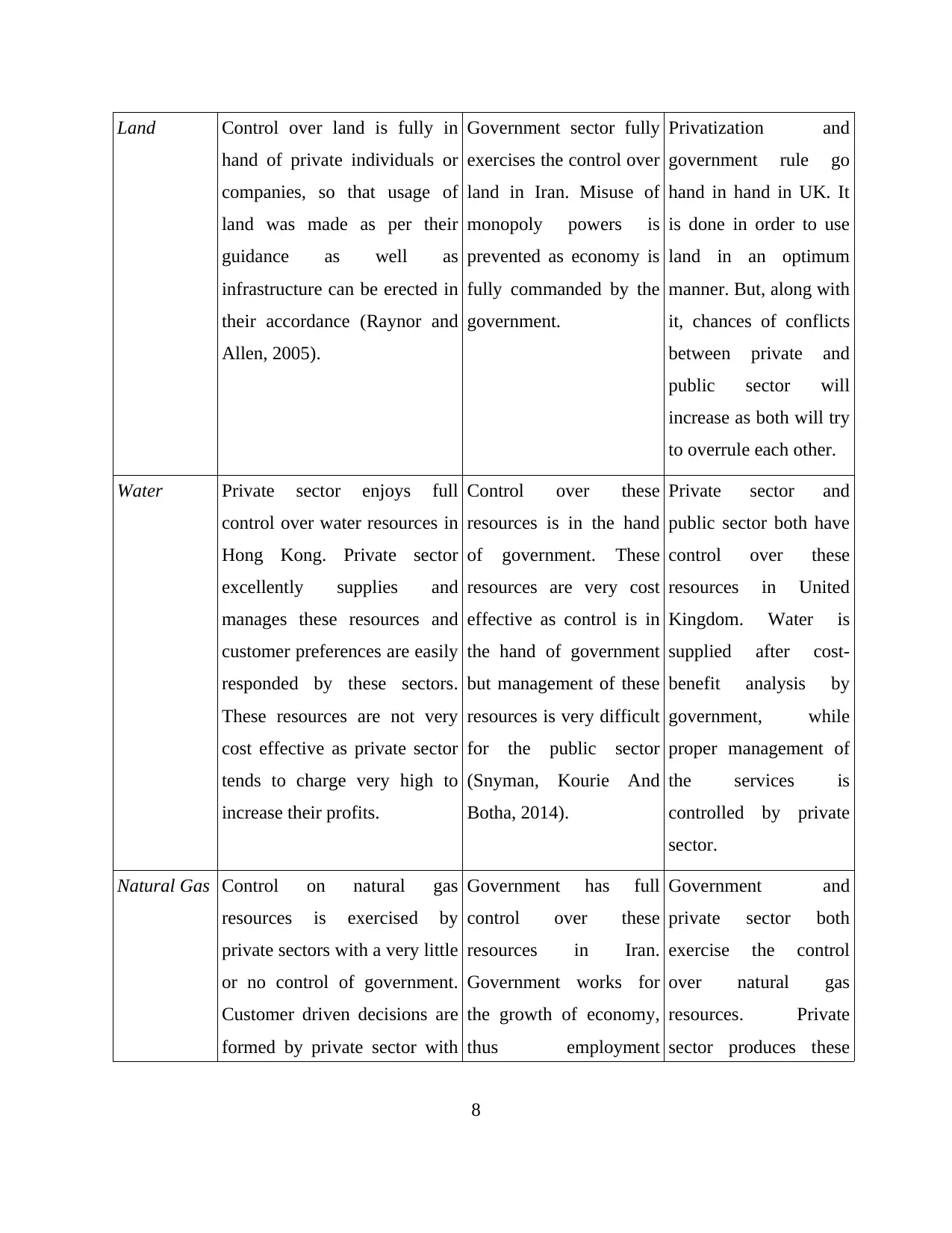
Land Control over land is fully in
hand of private individuals or
companies, so that usage of
land was made as per their
guidance as well as
infrastructure can be erected in
their accordance (Raynor and
Allen, 2005).
Government sector fully
exercises the control over
land in Iran. Misuse of
monopoly powers is
prevented as economy is
fully commanded by the
government.
Privatization and
government rule go
hand in hand in UK. It
is done in order to use
land in an optimum
manner. But, along with
it, chances of conflicts
between private and
public sector will
increase as both will try
to overrule each other.
Water Private sector enjoys full
control over water resources in
Hong Kong. Private sector
excellently supplies and
manages these resources and
customer preferences are easily
responded by these sectors.
These resources are not very
cost effective as private sector
tends to charge very high to
increase their profits.
Control over these
resources is in the hand
of government. These
resources are very cost
effective as control is in
the hand of government
but management of these
resources is very difficult
for the public sector
(Snyman, Kourie And
Botha, 2014).
Private sector and
public sector both have
control over these
resources in United
Kingdom. Water is
supplied after cost-
benefit analysis by
government, while
proper management of
the services is
controlled by private
sector.
Natural Gas Control on natural gas
resources is exercised by
private sectors with a very little
or no control of government.
Customer driven decisions are
formed by private sector with
Government has full
control over these
resources in Iran.
Government works for
the growth of economy,
thus employment
Government and
private sector both
exercise the control
over natural gas
resources. Private
sector produces these
8
hand of private individuals or
companies, so that usage of
land was made as per their
guidance as well as
infrastructure can be erected in
their accordance (Raynor and
Allen, 2005).
Government sector fully
exercises the control over
land in Iran. Misuse of
monopoly powers is
prevented as economy is
fully commanded by the
government.
Privatization and
government rule go
hand in hand in UK. It
is done in order to use
land in an optimum
manner. But, along with
it, chances of conflicts
between private and
public sector will
increase as both will try
to overrule each other.
Water Private sector enjoys full
control over water resources in
Hong Kong. Private sector
excellently supplies and
manages these resources and
customer preferences are easily
responded by these sectors.
These resources are not very
cost effective as private sector
tends to charge very high to
increase their profits.
Control over these
resources is in the hand
of government. These
resources are very cost
effective as control is in
the hand of government
but management of these
resources is very difficult
for the public sector
(Snyman, Kourie And
Botha, 2014).
Private sector and
public sector both have
control over these
resources in United
Kingdom. Water is
supplied after cost-
benefit analysis by
government, while
proper management of
the services is
controlled by private
sector.
Natural Gas Control on natural gas
resources is exercised by
private sectors with a very little
or no control of government.
Customer driven decisions are
formed by private sector with
Government has full
control over these
resources in Iran.
Government works for
the growth of economy,
thus employment
Government and
private sector both
exercise the control
over natural gas
resources. Private
sector produces these
8
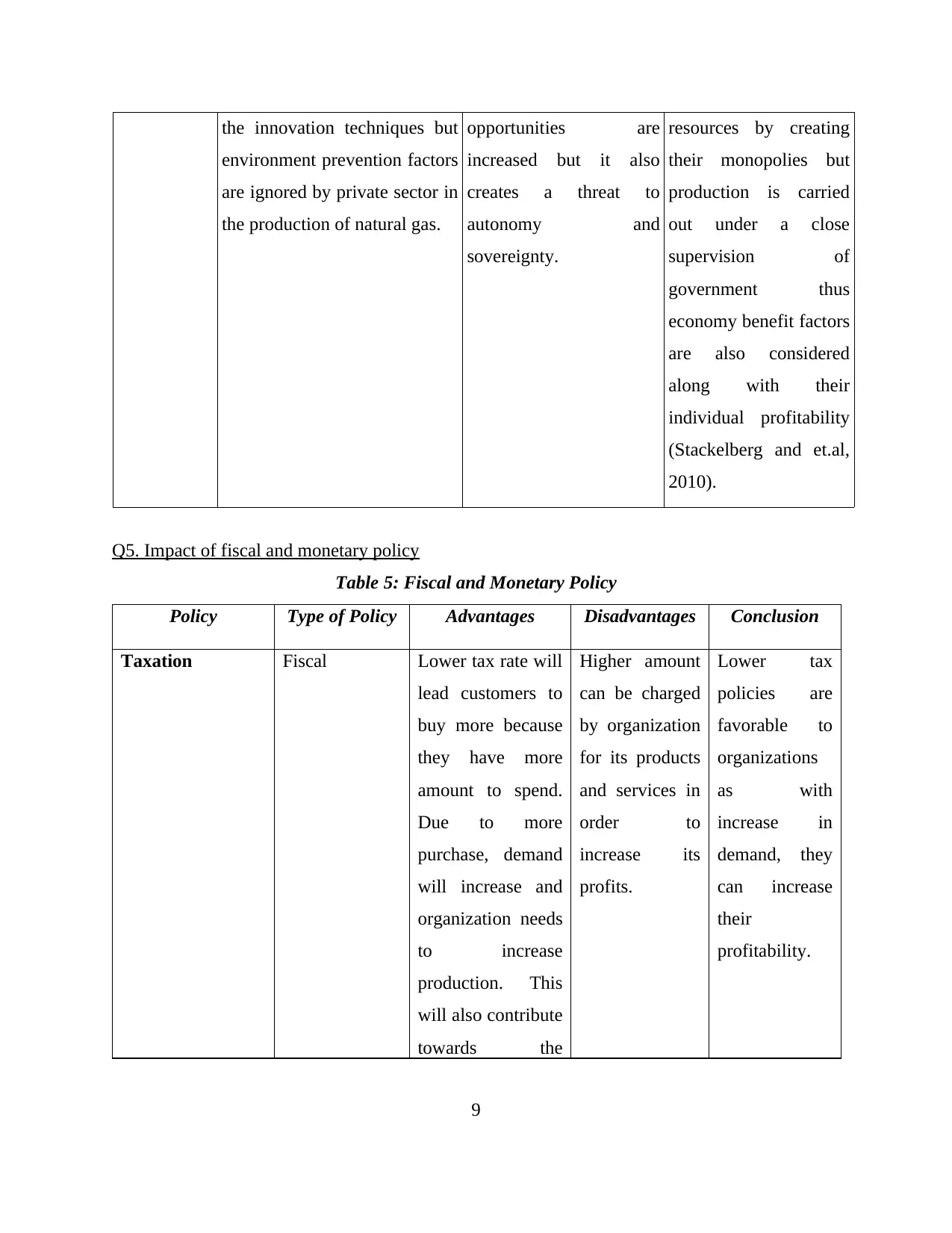
the innovation techniques but
environment prevention factors
are ignored by private sector in
the production of natural gas.
opportunities are
increased but it also
creates a threat to
autonomy and
sovereignty.
resources by creating
their monopolies but
production is carried
out under a close
supervision of
government thus
economy benefit factors
are also considered
along with their
individual profitability
(Stackelberg and et.al,
2010).
Q5. Impact of fiscal and monetary policy
Table 5: Fiscal and Monetary Policy
Policy Type of Policy Advantages Disadvantages Conclusion
Taxation Fiscal Lower tax rate will
lead customers to
buy more because
they have more
amount to spend.
Due to more
purchase, demand
will increase and
organization needs
to increase
production. This
will also contribute
towards the
Higher amount
can be charged
by organization
for its products
and services in
order to
increase its
profits.
Lower tax
policies are
favorable to
organizations
as with
increase in
demand, they
can increase
their
profitability.
9
environment prevention factors
are ignored by private sector in
the production of natural gas.
opportunities are
increased but it also
creates a threat to
autonomy and
sovereignty.
resources by creating
their monopolies but
production is carried
out under a close
supervision of
government thus
economy benefit factors
are also considered
along with their
individual profitability
(Stackelberg and et.al,
2010).
Q5. Impact of fiscal and monetary policy
Table 5: Fiscal and Monetary Policy
Policy Type of Policy Advantages Disadvantages Conclusion
Taxation Fiscal Lower tax rate will
lead customers to
buy more because
they have more
amount to spend.
Due to more
purchase, demand
will increase and
organization needs
to increase
production. This
will also contribute
towards the
Higher amount
can be charged
by organization
for its products
and services in
order to
increase its
profits.
Lower tax
policies are
favorable to
organizations
as with
increase in
demand, they
can increase
their
profitability.
9
⊘ This is a preview!⊘
Do you want full access?
Subscribe today to unlock all pages.

Trusted by 1+ million students worldwide
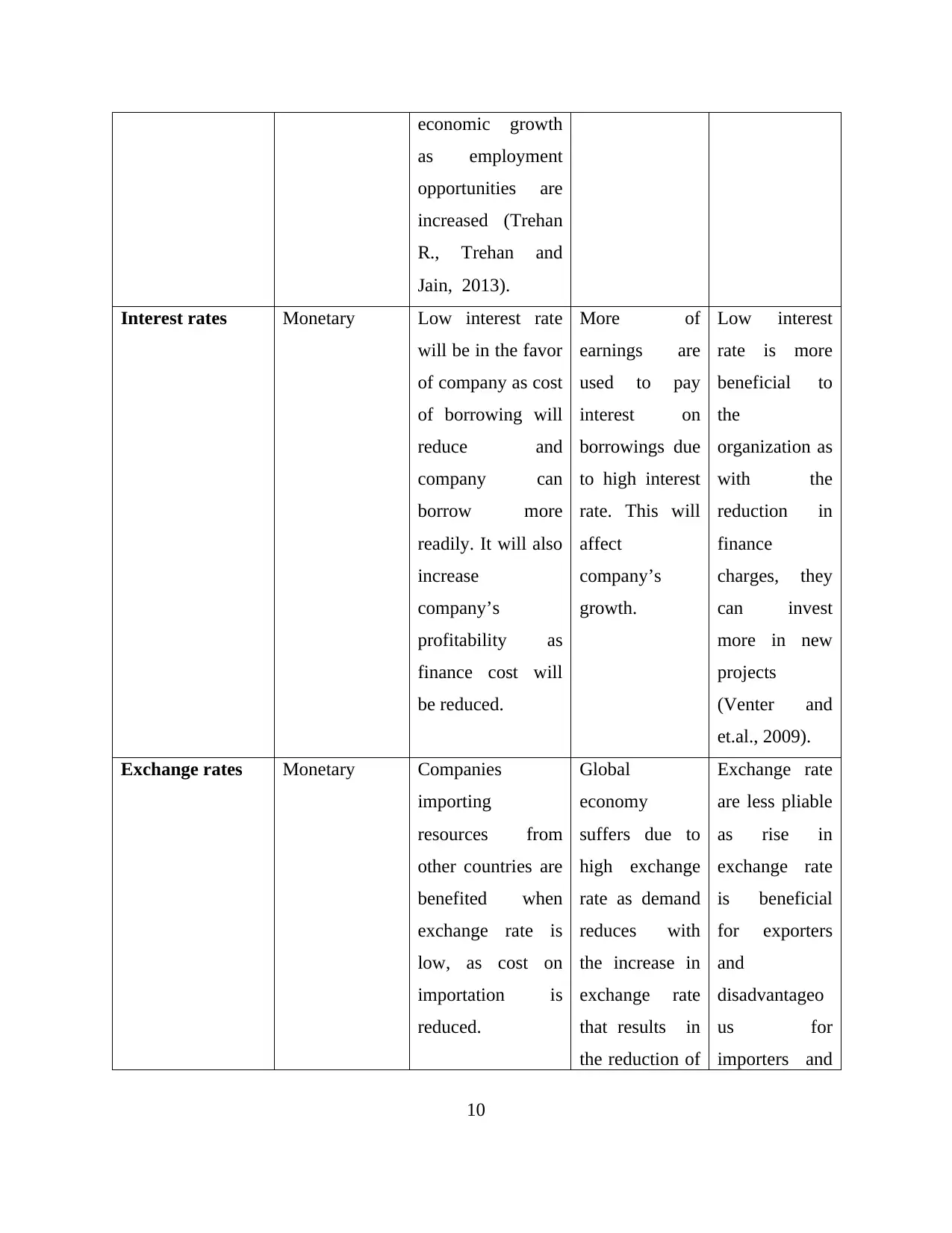
economic growth
as employment
opportunities are
increased (Trehan
R., Trehan and
Jain, 2013).
Interest rates Monetary Low interest rate
will be in the favor
of company as cost
of borrowing will
reduce and
company can
borrow more
readily. It will also
increase
company’s
profitability as
finance cost will
be reduced.
More of
earnings are
used to pay
interest on
borrowings due
to high interest
rate. This will
affect
company’s
growth.
Low interest
rate is more
beneficial to
the
organization as
with the
reduction in
finance
charges, they
can invest
more in new
projects
(Venter and
et.al., 2009).
Exchange rates Monetary Companies
importing
resources from
other countries are
benefited when
exchange rate is
low, as cost on
importation is
reduced.
Global
economy
suffers due to
high exchange
rate as demand
reduces with
the increase in
exchange rate
that results in
the reduction of
Exchange rate
are less pliable
as rise in
exchange rate
is beneficial
for exporters
and
disadvantageo
us for
importers and
10
as employment
opportunities are
increased (Trehan
R., Trehan and
Jain, 2013).
Interest rates Monetary Low interest rate
will be in the favor
of company as cost
of borrowing will
reduce and
company can
borrow more
readily. It will also
increase
company’s
profitability as
finance cost will
be reduced.
More of
earnings are
used to pay
interest on
borrowings due
to high interest
rate. This will
affect
company’s
growth.
Low interest
rate is more
beneficial to
the
organization as
with the
reduction in
finance
charges, they
can invest
more in new
projects
(Venter and
et.al., 2009).
Exchange rates Monetary Companies
importing
resources from
other countries are
benefited when
exchange rate is
low, as cost on
importation is
reduced.
Global
economy
suffers due to
high exchange
rate as demand
reduces with
the increase in
exchange rate
that results in
the reduction of
Exchange rate
are less pliable
as rise in
exchange rate
is beneficial
for exporters
and
disadvantageo
us for
importers and
10
Paraphrase This Document
Need a fresh take? Get an instant paraphrase of this document with our AI Paraphraser
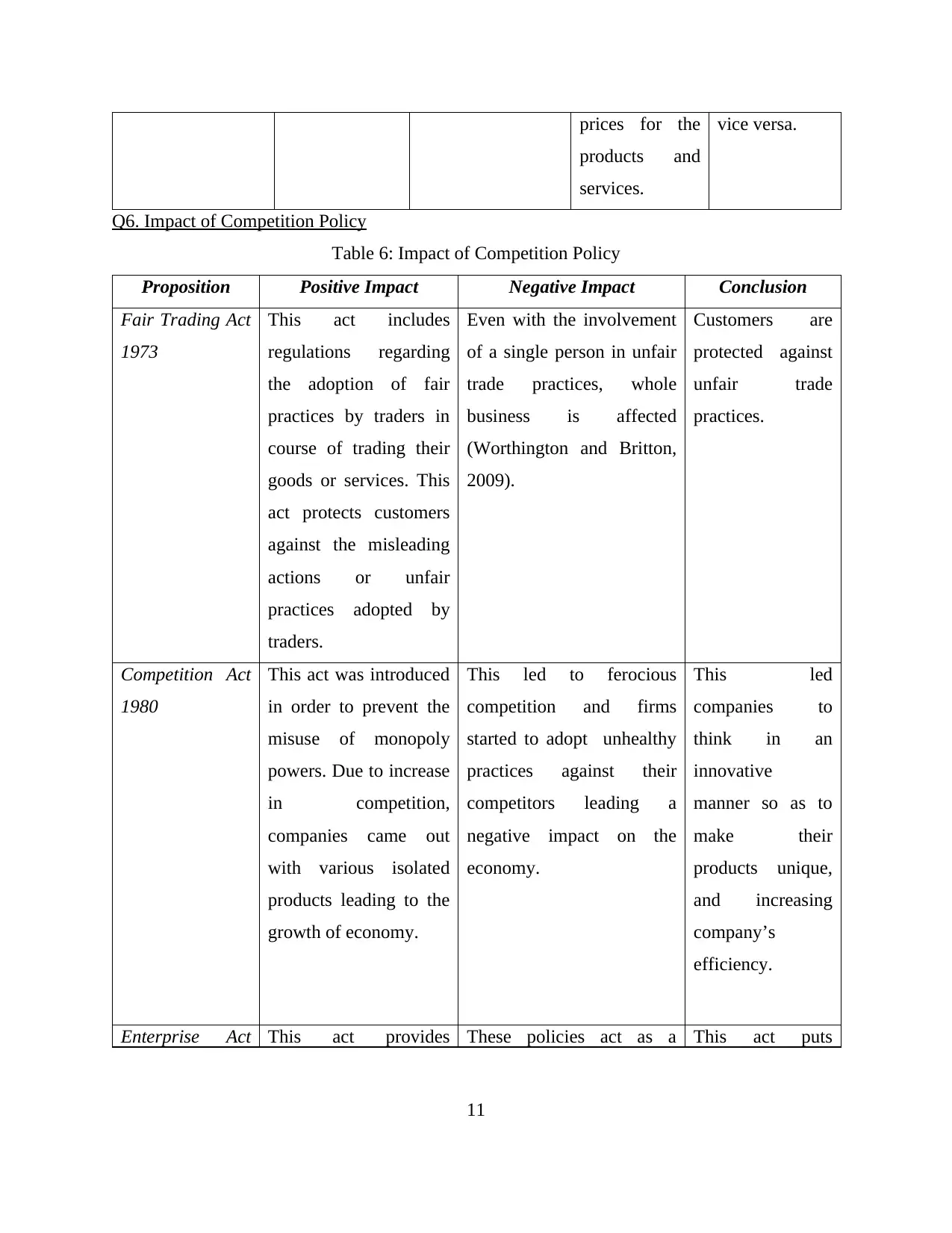
prices for the
products and
services.
vice versa.
Q6. Impact of Competition Policy
Table 6: Impact of Competition Policy
Proposition Positive Impact Negative Impact Conclusion
Fair Trading Act
1973
This act includes
regulations regarding
the adoption of fair
practices by traders in
course of trading their
goods or services. This
act protects customers
against the misleading
actions or unfair
practices adopted by
traders.
Even with the involvement
of a single person in unfair
trade practices, whole
business is affected
(Worthington and Britton,
2009).
Customers are
protected against
unfair trade
practices.
Competition Act
1980
This act was introduced
in order to prevent the
misuse of monopoly
powers. Due to increase
in competition,
companies came out
with various isolated
products leading to the
growth of economy.
This led to ferocious
competition and firms
started to adopt unhealthy
practices against their
competitors leading a
negative impact on the
economy.
This led
companies to
think in an
innovative
manner so as to
make their
products unique,
and increasing
company’s
efficiency.
Enterprise Act This act provides These policies act as a This act puts
11
products and
services.
vice versa.
Q6. Impact of Competition Policy
Table 6: Impact of Competition Policy
Proposition Positive Impact Negative Impact Conclusion
Fair Trading Act
1973
This act includes
regulations regarding
the adoption of fair
practices by traders in
course of trading their
goods or services. This
act protects customers
against the misleading
actions or unfair
practices adopted by
traders.
Even with the involvement
of a single person in unfair
trade practices, whole
business is affected
(Worthington and Britton,
2009).
Customers are
protected against
unfair trade
practices.
Competition Act
1980
This act was introduced
in order to prevent the
misuse of monopoly
powers. Due to increase
in competition,
companies came out
with various isolated
products leading to the
growth of economy.
This led to ferocious
competition and firms
started to adopt unhealthy
practices against their
competitors leading a
negative impact on the
economy.
This led
companies to
think in an
innovative
manner so as to
make their
products unique,
and increasing
company’s
efficiency.
Enterprise Act This act provides These policies act as a This act puts
11
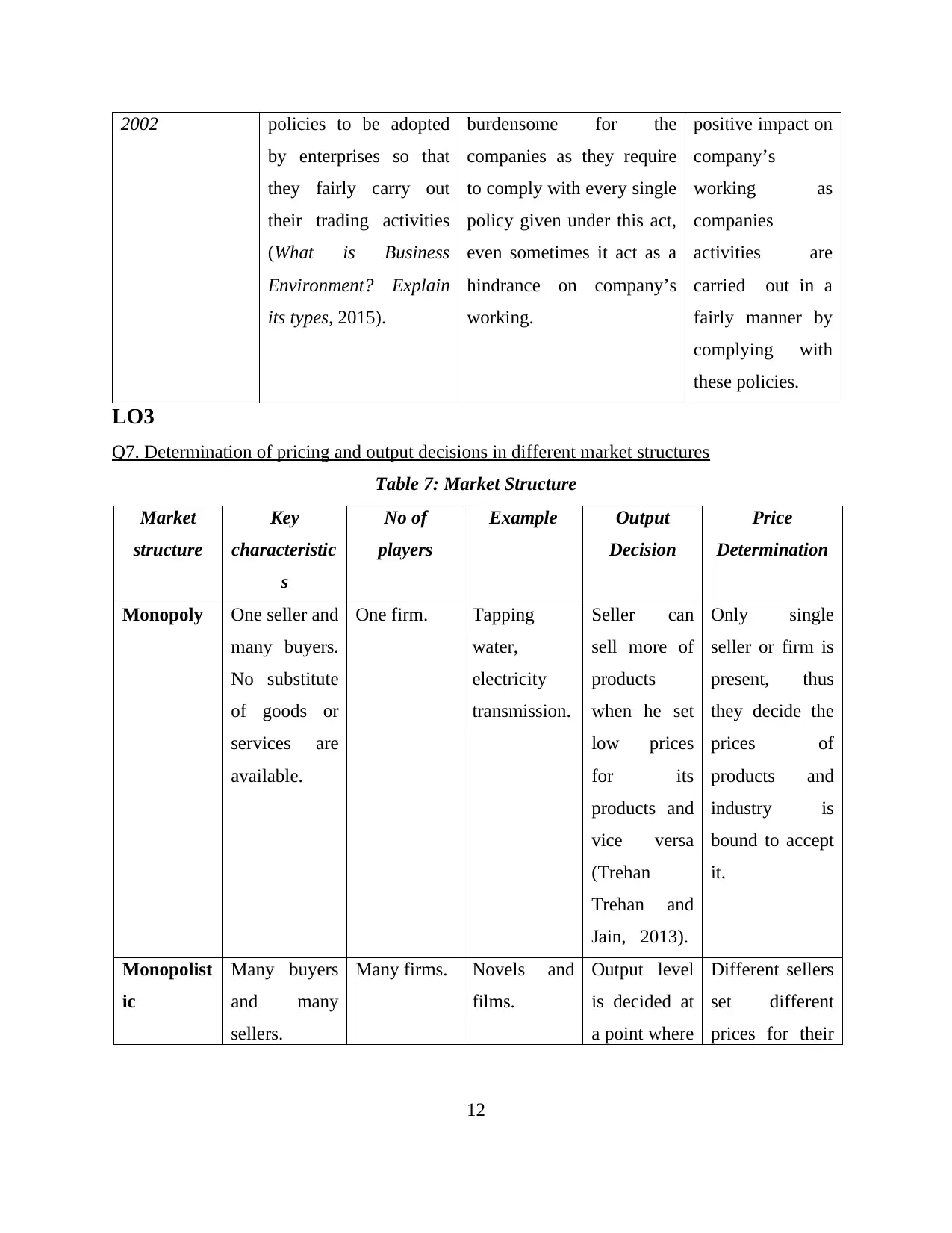
2002 policies to be adopted
by enterprises so that
they fairly carry out
their trading activities
(What is Business
Environment? Explain
its types, 2015).
burdensome for the
companies as they require
to comply with every single
policy given under this act,
even sometimes it act as a
hindrance on company’s
working.
positive impact on
company’s
working as
companies
activities are
carried out in a
fairly manner by
complying with
these policies.
LO3
Q7. Determination of pricing and output decisions in different market structures
Table 7: Market Structure
Market
structure
Key
characteristic
s
No of
players
Example Output
Decision
Price
Determination
Monopoly One seller and
many buyers.
No substitute
of goods or
services are
available.
One firm. Tapping
water,
electricity
transmission.
Seller can
sell more of
products
when he set
low prices
for its
products and
vice versa
(Trehan
Trehan and
Jain, 2013).
Only single
seller or firm is
present, thus
they decide the
prices of
products and
industry is
bound to accept
it.
Monopolist
ic
Many buyers
and many
sellers.
Many firms. Novels and
films.
Output level
is decided at
a point where
Different sellers
set different
prices for their
12
by enterprises so that
they fairly carry out
their trading activities
(What is Business
Environment? Explain
its types, 2015).
burdensome for the
companies as they require
to comply with every single
policy given under this act,
even sometimes it act as a
hindrance on company’s
working.
positive impact on
company’s
working as
companies
activities are
carried out in a
fairly manner by
complying with
these policies.
LO3
Q7. Determination of pricing and output decisions in different market structures
Table 7: Market Structure
Market
structure
Key
characteristic
s
No of
players
Example Output
Decision
Price
Determination
Monopoly One seller and
many buyers.
No substitute
of goods or
services are
available.
One firm. Tapping
water,
electricity
transmission.
Seller can
sell more of
products
when he set
low prices
for its
products and
vice versa
(Trehan
Trehan and
Jain, 2013).
Only single
seller or firm is
present, thus
they decide the
prices of
products and
industry is
bound to accept
it.
Monopolist
ic
Many buyers
and many
sellers.
Many firms. Novels and
films.
Output level
is decided at
a point where
Different sellers
set different
prices for their
12
⊘ This is a preview!⊘
Do you want full access?
Subscribe today to unlock all pages.

Trusted by 1+ million students worldwide
1 out of 20
Related Documents
Your All-in-One AI-Powered Toolkit for Academic Success.
+13062052269
info@desklib.com
Available 24*7 on WhatsApp / Email
![[object Object]](/_next/static/media/star-bottom.7253800d.svg)
Unlock your academic potential
Copyright © 2020–2025 A2Z Services. All Rights Reserved. Developed and managed by ZUCOL.





